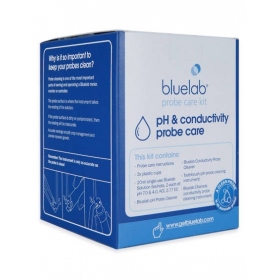- today
- perm_identity Rastamax
- label Hardware
- favorite 3 likes
- remove_red_eye 29451 views
- comment 0 comments
.png)
All about pH testers!
Welcome to this tutorial on how to use a pH tester! If you are interested in analysing the acidity or alkalinity of a solution repeatedly, this tool is essential. However, it is important to understand that pH testers can be both expensive and complex to use. Thus, special care must be taken in their use and maintenance to ensure an accurate and reliable measurement.
There are different types of pH testers, each with its own advantages and disadvantages. Some have a single electrode while others may have several, some are portable while others are designed to be permanently installed in a system. It is also important to read your tester's user manual carefully to ensure that you are aware of its features.
In this tutorial, we'll take you through the steps to using a pH tester effectively, giving you practical advice on how to avoid common mistakes and keep your meter in good condition. We hope this will help you understand the ins and outs of using a pH tester and get the most out of your investment.
Step 1: Preparing the tester
-
Remove the protective cap with KCl (storage solution) from the electronic pH tester.
-
Immerse the tester electrodes in water to clean them
-
Remove the electrodes from the water and wipe them gently with a clean cloth.
Step 2: Calibrate the tester
Calibrating the tester is an important step in ensuring the accuracy of your measurements. It is recommended that you calibrate your tester before each use, or at least once a day/week depending on the quality of your device.
-
Check the tester's manual to find out which calibration solutions are required and at which pH values they should be set.
-
Pour some of the calibration solution into a clean container and dip the tester's electrodes into the solution.
-
Wait for the tester to indicate the pH value of the calibration solution.
-
Repeat the previous step with another calibration solution, to ensure that the meter is properly calibrated to several pH points.
Step 3: Measuring the pH
-
Fill a clean container with the sample to be tested. If you are testing water from a tank, for example, mix it well before taking the sample.
-
Immerse the electrodes of the meter in the sample and wait for the pH value to appear on the display. Stir the meter slightly to mix the sample around the electrodes.
-
Note the pH value for your recording.
Step 4: Cleaning and storing the tester
-
Remove the electrodes from the sample and rinse them with clean water. Wipe them gently with a clean cloth.
-
Store the tester with the protective cap and storage fluid in a dry place out of direct sunlight.
Precautions to be taken
-
Handle the tester carefully, avoiding bumping or twisting the electrodes.
-
Do not touch the electrodes with bare fingers, as this may contaminate the electrodes and distort the measurements. If necessary, use rubber gloves.
-
Avoid exposing the tester to extreme temperatures, shock or vibration.
-
Clean the tester's electrodes after each use and store it carefully in a liquid storage container to prolong its life.
To go further
There are two types of pH testers on the market: temperature-compensated and non-temperature compensated.
Temperature-compensated pH testers have a built-in temperature sensor that allows the pH measurement to be corrected for temperature variations. This is because the pH measurement depends on the temperature of the sample, as this can affect the electrical conductivity of the electrolyte in the measuring probe. Temperature-compensated testers are therefore more accurate because they automatically correct for this temperature variation to ensure an accurate and reliable measurement
Non-temperature compensated pH testers do not have this feature. They do not have a built-in temperature sensor and therefore cannot correct the pH measurement for temperature changes. It is therefore important to take into account the temperature of the sample during measurement and calibration to ensure an accurate measurement.
As far as measuring probes are concerned, there are also two types of pH probes: double-junction and single-junction probes.
Double junction probes have two junctions, one for the pH measurement and one for the probe reference. The probe reference is filled with an electrolyte gel that helps maintain a constant reference potential. Double junction probes are recommended for samples containing proteins, sulphides or silver ions, which can interfere with the pH measurement, but also during prolonged submersion.
Single junction probes, on the other hand, have only one junction for pH measurement. They are more economical than double-junction probes but may be less accurate in the presence of samples containing substances that can interfere with the pH measurement.
In summary, temperature-compensated pH testers are more accurate because they automatically correct for temperature variation, whereas non-temperature-compensated testers require careful attention to the temperature of the sample to ensure an accurate measurement. Double junction probes are recommended for samples containing substances that may interfere with the pH measurement or in the case of continuous measurement, while single junction probes are more economical but may be less accurate in some situations.



Comments (0)